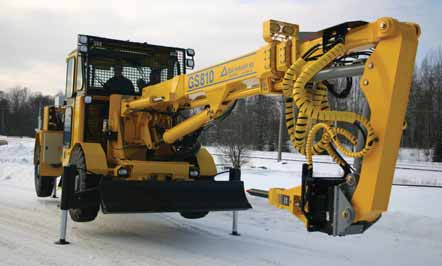
The GS 810 scaler, part of an extensive selection of utility equipment developed by GIA.
Utility Gear Keeps Mine Wheels Turning
By Russell A. Carter, Managing Editor

As reported last month (E&MJ, April 2007, “Chinese Iron Ore Mine Chooses Giamec Chargers, p. 90) GIA recently delivered three of its Giamec 211 charging trucks to the Da Hong Shan iron mine in Yunnan Province, China. The customer ordered the electric-hydraulic version of the unit, with an hydraulically driven 125- m-long electric cable run and onboard stepdown transformer. The Giamec 211 also features an hydraulically operated HL 150 boom with maximum working length of 6.616 m, and a 90º swing with a +60º/- 35º boom lift covering a 93-m2 area.
Another well-known manufacturer, the German firm Hermann Paus Maschinenfabrik, also offers a wide line of mine utility vehicles ranging from its TSL (telescopic swivel loader) unit, which can be configured as a scaler or other utility tool, to the Universa 50 carrier that can be fitted with a concrete mixer, scissor lift platform, tanks, explosives charging unit and other options. For additional details on these Paus products and others, see E&MJ’s bauma 2007 pre-show coverage (“bauma Returns with a Large Mining Component,” April 2007, p. 36).
Ontario, Canada-based Marcotte Mining Machinery’s M-10 personnel truck is a rugged four-wheel-drive underground vehicle designed to carry six people in its rear box as well as a driver and front passenger. Powered by a 100-hp Perkins diesel connected to a four speed-forward/ four-reverse powershift transmission, the M-10 is 14.75 ft long (with bumpers), 74 in. wide and stands 57 in. high without a cab (88 in. with cab). Empty vehicle weight is 9,500 lb without cab or canopy, and payload capacity is 4,000 lb.
Ontario-based manufacturer, Industrial Fabrication Inc., builds the Minecat 100PC, TN75 and 806 underground utility vehicles, along with the compact Mine Mule and the Load Lifter mine forklift. The Mine Mule is designed to haul up to 800 lb and can be configured with rear bench seating, an enclosed cab, and an approved four-wheel, self-adjusting, sealed hydraulic drum brake system. Other mechanical features include heavy duty leaf springs with coil over shock rear suspension and independent MacPherson strut front suspension; an engine retarder which automatically engages to slow the vehicle to a crawl when the throttle is released; and a steering damper to guard against steering wheel kick-back while traveling over rough terrain.
Normet Corp. designed its RBO utility vehicle specifically for underground use. Powered by a 96-kW (128-hp) Deutz BF4M 2012 or 97-kW Caterpillar 3054 diesel linked to a two-speed-range hydrostatic transmission, the RBO is sized to operate efficiently in narrow passages. The electronically controlled transmission, Orbitrol-type power steering (shiftable from right to left side), and two-circuit, oilimmersed multidisc service brakes work with a double-parabolic leaf spring suspension in front and rear and heavy-duty shock absorbers to provide high maneuverability and drivability in underground situations. In the passenger compartment, sound insulation, a filtered fresh-air blower system, interior lighting, cabin heating and other features have been designed for durability and convenience, while the interior layout offers room for five persons sitting on T-backed seats that have strategically placed cutout sections to make room for miners’ equipment belts. The vehicle’s tube frame supports an open cargo bed with 1-mt carrying capacity; bed options include a trailer hitch and cargo crane.
For above-ground maintenance and transport, Bobcat’s 2300 4x4 utility vehicle features the RapidLink attachment system, with an attachment arm that can lift 500-lb loads as high as 2 ft. The 20-hp Bobcat’s continuously variable transmission provides high torque and travel speeds up to 25 mph. Other features include a rust-proof aluminum frame, a power cargo dump box with 800-lb load capacity, and seats, hood, and cargo box that can be easily lifted for access to routine maintenance items such as engine oil, radiator coolant, and brake fluid levels.
Canada-based Ontario Drive & Gear Ltd.’s Argo 8x8 Avenger utility ORV is equipped with a 26-hp Kohler Aegis LH690 liquid-cooled engine and is now available with an optional 3.3 high-ratio transmission for improved erformance when the vehicle is fitted with rubber tracks. The all-wheel-drive Avenger seats six people, has a load capacity of up to 1,150 lb and can tow 1,800 lb. For demanding applications, a lightweight and durable endless-belt rubber track system can be installed over the tires.
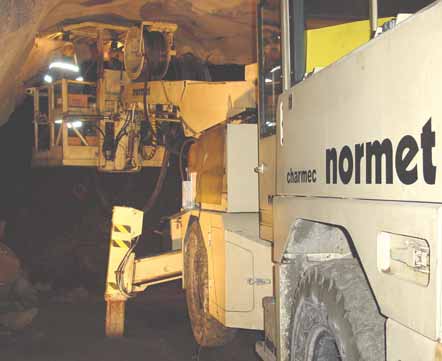
Rocmec charging and scaling equipment is manufactured by GIA under an agreement with Dyno Nobel that combines GIA’s mechanical skills and Dyno Nobel’s knowledge of explosives and charging techniques. The Rocmec DC is equipped with the latest Nitro Nobel compressed air charger and a mechanical hose pusher, and is available with a choice of Atlas Copco carriers. GIA also supplies ANFO mixing equipment.
Rocmec scalers are manufactured in both electric hydraulic and diesel hydraulic versions.
Service at the Surface
Although there’s a definite trend toward designing compact, highly maneuverable
utility vehicles—particularly for underground use—there’s
also no law against building them big; in certain cases, “big” is
mandatory. For example, Ground Force Manufacturing, which specializes
in building mine support equipment, developed a special order fuel/lube truck
for a Wyoming mine that could service the production equipment during a full
shift without repeatedly returning to a fuel depot to refill its fuel and product
tanks.
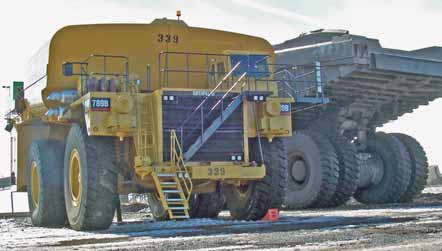
The jumbo service truck carries a 22,000-gallon fuel tank; nine heated product tanks with a total capacity of more than 6,000 gallons; a 3,500-lb-capacity heated grease bin; hydraulic-powered diesel fuel, oil product and grease pumps; air-operated diaphragm pumps for coolant and waste oil; 15 Hannay electric and spring-rewind hose reels; a Palatek electric- drive rotary screw 80-cfm air compressor with 200-gallon receiver; a heated reel compartment; and a 104,000-Btu, diesel-fired heating system. An onboard 125-kW diesel-driven generator system allows the body to function independently of the chassis, so if the chassis were to break down, the body could be utilized as a fuel and lube farm, able to service equipment until the chassis is repaired.
Iowa Mold Tooling Co. (IMT) recently enhanced its popular Dominator IV mechanics truck to give operators more comfort and mobility around the vehicle, and also announced a new telescopic crane—the 8025—designed to accompany the redesigned truck body. The new version of the Dominator IV truck is the first service body on the market that can accommodate an 80,000 ft-lb crane, according to the company.
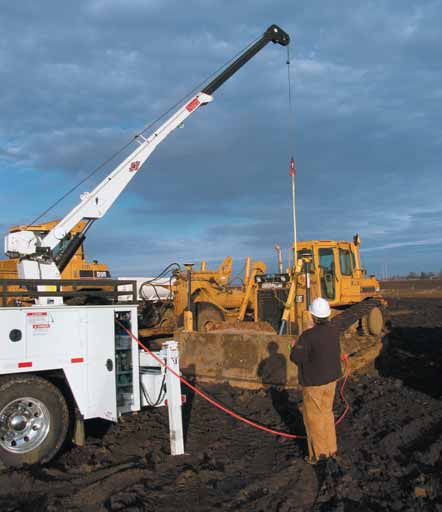
In addition to the top-of-the-line 8025 crane, customers can specify other models of IMT telescopic cranes that will fit on the Dominator IV body, including the 5525 (55,000 ft-lb), 6025 (60,000 ft-lb), 6625 (66,000 ft-lb) and 7025 (70,000 ft-lb). Customers may also choose between the 19-ft body, which is designed for a tandem rear axle chassis, or the 14-ft body, which is designed for a single rear axle chassis.
For larger lifting demands, Manitowoc Crane Group has developed a long-boom version of the Grove GMK4100 (GMK4115 in the U.S.) all-terrain crane that was launched at Intermat 2006. The long-boom version incorporates the same features as the standard version, but is fitted with a 60-m (197-ft) seven-section main boom, which telescopes to maximum reach in less than nine minutes. The 100- mt GMK4100-L has a maximum tip height of 83 m (272 ft), while features shared with the standard GMK4100 include a 295-kW (390-hp) Mercedes Benz carrier engine, a 110-kW (147.5-hp) direct fuel injection superstructure engine, and up to 26.1 mt of counterweight.
Portable Air and Power
Two divisions of Atlas Copco have recently introduced new products that can
fill specific niches of utility service. Atlas Copco’s Portable Air division
unveiled two highpressure compressors: the XRXS 566 (XRXS 1206) for
30 bar (435 psi) operation and the XRVS 606 (XRVS 1256) for 25 bar
(365 psi) operation.
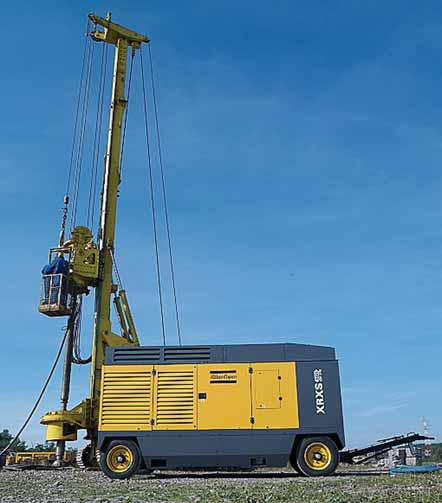
The new models are available in wagonundercarriage, support truck-mounted or skid-mounted versions. Both compressors are fitted with the FuelXpert system which employs a combination of hardware (regulating valve, inlet throttle and regulating system) and proprietary software that measures regulating pressure and engine speed. With this feature, fuel consumption is claimed to be 10% lower than comparable units, and even higher when running at partial load. XRXS and XRVS units are also fitted with the Atlas Copco Oiltronix system which electronically controls the compressor regulating and oil cooling systems in order to maintain oil injection temperatures at optimum levels.
For portable power requirements, Atlas Copco’s new QAS 125 and 150 generating sets feature continuous prime ratings of 125 kVA and150 kVA at 50 Hz. The sets are powered by a Volvo Penta four-stroke six-cylinder diesel engine with direct injection, turbo-charged and inter-cooled. According to the company, the new sets are now housed within a significantly smaller housing than previous models. A soundattenuated and rugged Zincor steel enclosure ensures the units comply with European sound regulations (OND 2000/14 EC). The fuel tank is now centrally placed so that regardless of how much the fuel tank is filled, the unit remains balanced.
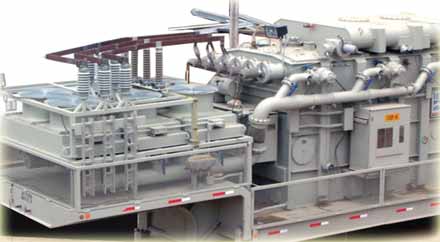
Unifin, a supplier of cooling equipment and transformer oil pumps and valves for electrical generation systems, has introduced ForZair mobile transformer oil coolers, available in standard sizes and configurable designs to simplify the purchasing process and ensure quick delivery. ForZair coolers feature Unifin’s mono-aluminum extruded fin-tubes and plate fin technology, both of which are claimed to provide optimal heat transfer efficiency and exceptional durability. The mobile coolers are designed to work with Cardinal transformer oil pumps, which utilize a glandless design to prevent leaks in demanding transformer oil applications. ForZair coolers are available with a performance range of 125-750 kW, for oil flows of 200 gpm to 650 gpm and a top oil rise (TOR) of 35ºC–63ºC. Options include exterior surface treatment, with galvanized finish standard. A two-part epoxy paint option is available for chemically aggressive environments and a durable three-part system is available for marine environments.